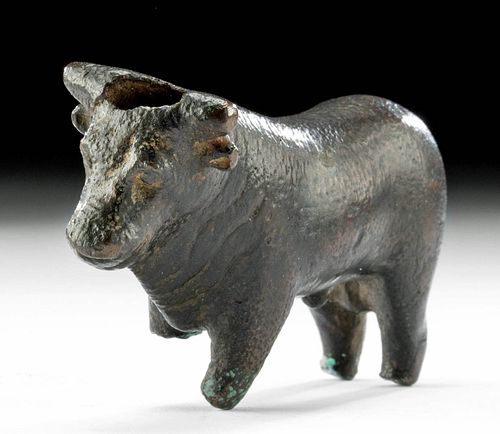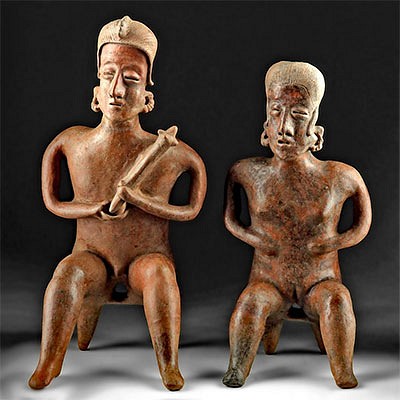Egyptian Bronze Apis Bull
Lot 13
About Seller
Artemis Fine Arts
686 S Taylor Ave, Ste 106
Louisville, CO 80027
United States
Selling antiquities, ancient and ethnographic art online since 1993, Artemis Gallery specializes in Classical Antiquities (Egyptian, Greek, Roman, Near Eastern), Asian, Pre-Columbian, African / Tribal / Oceanographic art. Our extensive inventory includes pottery, stone, metal, wood, glass and textil...Read more
Estimate:
$600 - $900
Absentee vs Live bid
Two ways to bid:
- Leave a max absentee bid and the platform will bid on your behalf up to your maximum bid during the live auction.
- Bid live during the auction and your bids will be submitted real-time to the auctioneer.
Bid Increments
| Price | Bid Increment |
|---|---|
| $0 | $25 |
| $300 | $50 |
| $1,000 | $100 |
| $2,000 | $250 |
| $5,000 | $500 |
| $10,000 | $1,000 |
| $20,000 | $2,500 |
| $50,000 | $5,000 |
| $100,000 | $10,000 |
| $200,000 | $20,000 |
About Auction
By Artemis Fine Arts
Mar 25, 2021
Set Reminder
2021-03-25 10:00:00
2021-03-25 10:00:00
America/New_York
Bidsquare
Bidsquare : CLEARANCE Antiquities | Ethnographic Art
https://www.bidsquare.com/auctions/artemis-gallery/clearance-antiquities-ethnographic-art-6663
Featuring discounted pricing on Asian art, Classical antiquities from Egypt, Greece, Italy, and the Near East...plus Pre-Columbian, Tribal, Russian Icons, Spanish Colonial, Fine Art, more! Artemis Fine Arts info@artemisfinearts.com
Featuring discounted pricing on Asian art, Classical antiquities from Egypt, Greece, Italy, and the Near East...plus Pre-Columbian, Tribal, Russian Icons, Spanish Colonial, Fine Art, more! Artemis Fine Arts info@artemisfinearts.com
- Lot Description
**Originally Listed At $300**
Egypt, Late Dynastic Period, ca. 664 to 525 BCE. A remarkable Egyptian cast bronze Apis bull standing with one leg stretched slightly forward. This petite figure's head is molded with an impressive amount of detail, featuring two horizontal cone-shaped horns followed by leaf-shaped ears that flank a broad snout with flared nostrils and a long mouth. The beast's thick neck is decorated with four wavy lines of varying lengths on either side, to represent folds of flesh. Similarly, its strong build is textured with scattered dots and lines to highlight his fur. Apis bulls were immensely important in Ancient Egypt and when one died, Egyptians would leave small votives, such as this, at the burial site. A rare and intriguing find! Size: 3.5" L x .875" W x 1.875" H (8.9 cm x 2.2 cm x 4.8 cm)
Apis was originally worshipped by Narmer, the ruler who unified Upper and Lower Egypt around 3000 BCE - the sacred bull is shown trampling the pharaoh's enemies on the Narmer palette that commemorates the unification. Three thousand years later, by the time of Roman control of Egypt, the worship continued. Though centered around the city of Memphis, the cult of Apis was so extensive in Egypt that the Greeks and Romans wrote about it repeatedly. The famous French archaeologist Mariette, excavating at the Serapeum of Saqqara, found the mummified remains of more than sixty bulls, some buried in their own separate tombs.
An example of a similar Apis Bull votive can be found at the Brooklyn Museum (Accession Number: 05.367).
Provenance: ex-Estate of Eldert Bontekoe, Pegasi Numismatics, Ann Arbor, Michigan USA acquired before 2000
All items legal to buy/sell under U.S. Statute covering cultural patrimony Code 2600, CHAPTER 14, and are guaranteed to be as described or your money back.
A Certificate of Authenticity will accompany all winning bids.
We ship worldwide and handle all shipping in-house for your convenience.
#157959Missing some projecting details, as well as a small piece atop the head. Expected abrasions, scratches, and nicks. Remnants of an adhesive are present on the ends of each leg, likely from previous display. Lovely earthen deposits throughout.Condition
- Shipping Info
-
All shipping is handled in-house for your convenience. Your invoice from Artemis Gallery will include shipping calculation instructions. If in doubt, please inquire BEFORE bidding for estimated shipping costs for individual items.
-
- Buyer's Premium



 EUR
EUR CAD
CAD AUD
AUD GBP
GBP MXN
MXN HKD
HKD CNY
CNY MYR
MYR SEK
SEK SGD
SGD CHF
CHF THB
THB
















